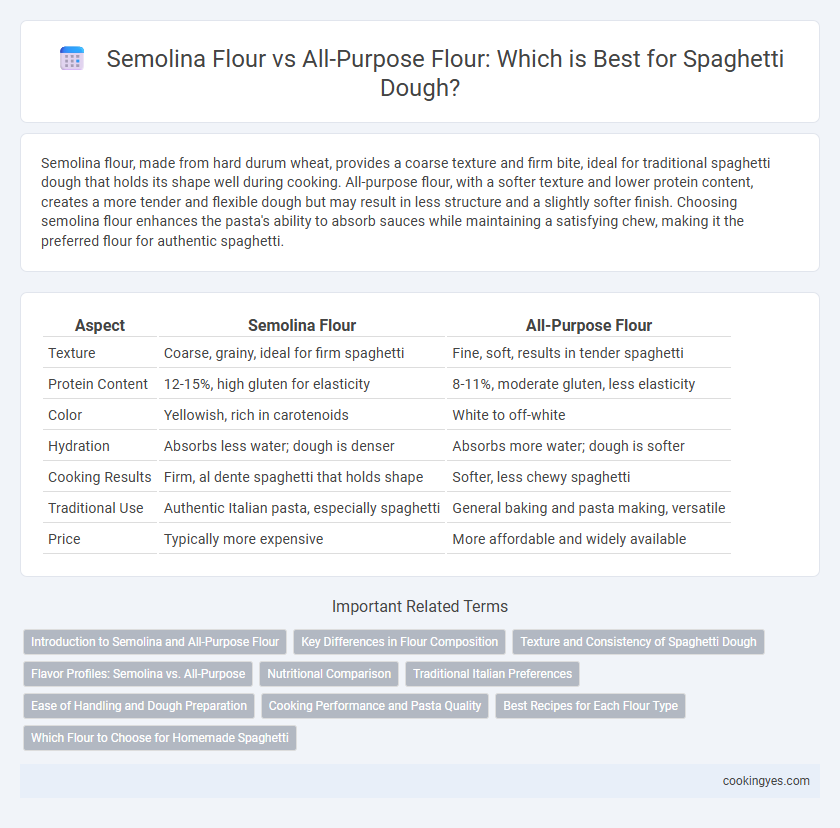Semolina flour, made from hard durum wheat, provides a coarse texture and firm bite, ideal for traditional spaghetti dough that holds its shape well during cooking. All-purpose flour, with a softer texture and lower protein content, creates a more tender and flexible dough but may result in less structure and a slightly softer finish. Choosing semolina flour enhances the pasta's ability to absorb sauces while maintaining a satisfying chew, making it the preferred flour for authentic spaghetti.
Table of Comparison
| Aspect | Semolina Flour | All-Purpose Flour |
|---|---|---|
| Texture | Coarse, grainy, ideal for firm spaghetti | Fine, soft, results in tender spaghetti |
| Protein Content | 12-15%, high gluten for elasticity | 8-11%, moderate gluten, less elasticity |
| Color | Yellowish, rich in carotenoids | White to off-white |
| Hydration | Absorbs less water; dough is denser | Absorbs more water; dough is softer |
| Cooking Results | Firm, al dente spaghetti that holds shape | Softer, less chewy spaghetti |
| Traditional Use | Authentic Italian pasta, especially spaghetti | General baking and pasta making, versatile |
| Price | Typically more expensive | More affordable and widely available |
Introduction to Semolina and All-Purpose Flour
Semolina flour, derived from durum wheat, possesses a coarse texture and high protein content that enhances the elasticity and bite of spaghetti dough, making it ideal for traditional pasta. All-purpose flour, milled from a blend of hard and soft wheat, offers a finer texture and moderate protein level suitable for softer, more tender pasta varieties. Choosing semolina flour for spaghetti results in a firmer, more al dente texture, while all-purpose flour produces a lighter, less chewy noodle.
Key Differences in Flour Composition
Semolina flour, made from durum wheat, contains a higher protein and gluten content compared to all-purpose flour, providing pasta dough with a firmer texture and al dente bite. All-purpose flour, derived from a blend of hard and soft wheat, has a lower protein level, resulting in a softer and more tender spaghetti texture. The coarse granules of semolina also enhance dough elasticity and water absorption, critical for traditional pasta consistency.
Texture and Consistency of Spaghetti Dough
Semolina flour, made from durum wheat, provides a coarse texture and higher protein content that creates a firm, elastic spaghetti dough, ideal for maintaining bite and resilience during cooking. All-purpose flour yields a softer, more pliable dough with less gluten strength, resulting in a smoother texture but a less chewy consistency. Choosing semolina flour enhances the traditional al dente texture of spaghetti, while all-purpose flour produces a tender, less structured pasta.
Flavor Profiles: Semolina vs. All-Purpose
Semolina flour, derived from durum wheat, imparts a nutty, slightly sweet flavor and a firm texture to spaghetti dough, enhancing the pasta's bite and mouthfeel. All-purpose flour, milled from a blend of wheat varieties, produces a softer dough with a milder taste, allowing sauces and seasonings to take center stage. Choosing semolina flour intensifies traditional Italian flavor profiles, while all-purpose flour offers a subtler base for versatile culinary applications.
Nutritional Comparison
Semolina flour for spaghetti dough contains higher protein and gluten content than all-purpose flour, enhancing dough elasticity and providing more essential amino acids. It also offers a richer supply of B vitamins and iron, improving the nutritional profile of the pasta. All-purpose flour, while more versatile, generally contains fewer nutrients and less fiber, making semolina a healthier choice for traditional spaghetti.
Traditional Italian Preferences
Traditional Italian spaghetti dough is typically made with semolina flour, prized for its coarse texture and high protein content that provides excellent gluten development, resulting in firm, al dente pasta. Semolina imparts a distinct yellow hue and slightly nutty flavor, characteristics highly valued in authentic Italian cuisine. All-purpose flour, while more versatile and softer, tends to produce a less resilient dough, making it less favored by traditional Italian pasta makers.
Ease of Handling and Dough Preparation
Semolina flour, made from durum wheat, provides a coarser texture that enhances dough elasticity but can be slightly harder to knead, requiring more water for optimal hydration. All-purpose flour, with its finer grind and moderate protein content, offers smoother handling and easier dough preparation, making it suitable for beginners. The choice between semolina and all-purpose flour impacts dough firmness and workability, influencing the final spaghetti texture.
Cooking Performance and Pasta Quality
Semolina flour, with its high protein content and coarse texture, produces a firmer spaghetti dough that holds shape well during cooking, yielding a slightly al dente bite and robust mouthfeel. All-purpose flour, being finer and lower in gluten strength, results in a softer dough that cooks faster but can lead to stickier, less resilient spaghetti strands. Choosing semolina flour enhances pasta quality by providing better texture, durability, and cooking performance ideal for traditional Italian spaghetti dishes.
Best Recipes for Each Flour Type
Semolina flour yields a firm, al dente texture ideal for traditional Italian spaghetti recipes, enhancing the dough's elasticity and golden color. All-purpose flour creates a softer, more tender pasta suitable for delicate sauces and home-style dishes, offering easier handling and a smoother finish. Best recipes with semolina include classic spaghetti alla carbonara and spaghetti aglio e olio, while all-purpose flour excels in creamy spaghetti recipes like Alfredo or simple tomato-based sauces.
Which Flour to Choose for Homemade Spaghetti
Semolina flour, made from durum wheat, provides a coarse texture and high protein content ideal for creating firm, al dente spaghetti with excellent bite and rich flavor. All-purpose flour, though more versatile and widely available, produces a softer dough that may result in less structure and a more tender pasta. For homemade spaghetti aiming for traditional texture and durability, semolina flour is the preferred choice, while all-purpose flour suits recipes requiring a delicate finish or limited ingredient access.
Semolina flour vs All-purpose flour for spaghetti dough Infographic

 cookingyes.com
cookingyes.com